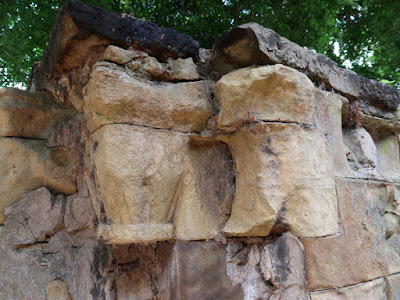 |
| Weathered capitals from the resited Chapel of St. Mary Magdalene |
During my brief investigation of the exterior of St. Margaret’s church in Swinton, Rotherham, I could easily have missed the remains of the of Chapel of St. Mary Magdalene, which was a Norman chapel of ease to All Saints church in Wath upon Dearne, dated c.1200.
The chapel was originally sited just over 200 metres away, where the church hall at Chapel Hill now stands, but it was demolished in 1815 and the remains were rebuilt in Vicarage Field on the north side of the present church.
When the south door was rebuilt, it comprised an arch with three orders and an 1817 engraving and a later photograph for a post card, which are reproduced in the Corpus of Romanesque Sculpture website, show that it was decorated with grotesques, beakheads and chevrons.
Deterioration of the stonework over the years led to many of the carved sections of stone being taken away in 1950 and placed in storage, although I have no information where they were kept or if they still exist.
Very little of the carved masonry remains today, which includes two badly weathered scalloped capitals and fragments of two orders of colonnettes, both of which are made in yellow Permian dolomitic limestone of unknown provenance.
The sandstone used for the general walling is medium grained, with considerable colour variations – grey/yellow/orange/brown – and is generally quite soft and heavily weathered. To the east doorway, the remaining moulded blocks are more massive and reddish brown in colour and look like the Rotherham Red variety of the Mexborough Rock.
In places, the sandstone is slightly coarser grained and exhibits both planar and cross bedding, with differential weathering of the softer beds and the development of a greyish/light brown patina, which looks quite different in character to the other multicoloured sandstone seen in the walling.
During a quick wander around the extensive churchyard, I discovered various ‘granite’ monuments, some of which are made in decorative stones that are very commonly used in memorials and with which I was familiar. Others, however, were not immediately recognisable, especially when left with a rough finish that does not show the colours and textures clearly.
As usual, I kept my open for any Commonwealth War Graves and discovered the monument to J.W. Harrison, which is made in botticino marble and is set by one of the old sandstone boundary walls, and another in the traditional Portland stone to Arthur Edward Mann – both of whom were in the York and Lancaster Regiment.









No comments:
Post a Comment